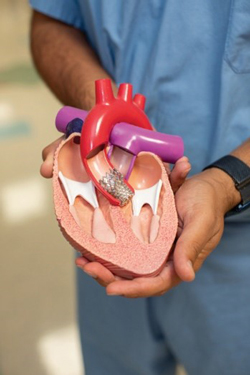
Milford resident Nancy Earel underwent a transcatheter aortic valve replacement (TAVR) procedure that saved her life. The procedure involved replacing a faulty heart valve due to symptomatic severe aortic valve stenosis, a condition that can be fatal if left untreated.
Nancy Earel, a retired nurse, is familiar with matters of the heart. It started a few years ago with atrial fibrillation, an irregular and often very rapid heart rhythm that can lead to blood clots and increase the risk of stroke, heart failure and other related complications.
“I noticed I was getting a bit out of breath,” said Earel, who underwent a cardiac ablation in 2022 to treat her irregular heartbeat.
While the cardiac ablation restored the rhythm of her heart, an echocardiogram revealed another issue brewing: By February 2023, Earel had developed symptomatic severe aortic valve stenosis, a type of heart valve disease that can lead to congestive heart failure and even death. Up to 7 percent of people over age 65 may develop some degree of aortic stenosis in their lifetime.
“When patients with symptomatic severe aortic stenosis don’t get their heart valve replaced, the mortality risk is high with medical therapy alone,” said
Chirag A. Shah, MD, director of Structural Heart Disease at Bridgeport Hospital Heart and Vascular Center (HVC) and a cardiologist at Cardiac Specialists, part of Northeast Medical Group.
After an extensive cardiac workup, for some patients like Earel, a transcatheter aortic valve replacement, commonly known as
TAVR can help improve symptoms and prolong life. Symptoms of severe aortic stenosis may include shortness of breath, fatigue, dizziness and fainting.
TAVR is a minimally invasive procedure to replace a stenotic aortic valve, which controls blood flow to, from and within the heart.
Forefront of care

Chirag A. Shah, MD, and Catherine Wright, APRN, were part of Earel’s TAVR team at Bridgeport Hospital.
Yale New Haven Health’s Heart and Vascular Center was the first health system in Connecticut to receive Transcatheter Valve Certification by the American College of Cardiology. Since 2016, nearly 3,000 TAVR procedures have been performed across Bridgeport and Yale New Haven hospitals.
“We do about 90 TAVR procedures a year – about two to three a week,” said Catherine Wright, APRN, the Valve Clinic coordinator who has been with the program at Bridgeport Hospital since its inception. Wright is also Structural Heart-Lead, HVC, Northeast Medical Group/Bridgeport Hospital, YNHHS.
Following a cardiologist’s referral, patients undergo specialized scans to ensure access to the stenotic valve. If the patient is not having symptoms, an echocardiogram will show the extent of disease, Wright explained.
TAVR benefits

With a TAVR procedure, the new aortic valve is placed inside the old one. The new valve, which can be seen at the center of this aortic valve model, can range in size from the smallest at 20 mm to the largest at 34 mm.
When patients undergo TAVR, a team consisting of an interventional cardiologist and a cardiac surgeon replaces the aortic valve by inserting a replacement valve on a catheter that enters the body through a small incision from the groin. Once in place, the new valve is expanded pushing aside the leaflets (the flaps that open and close) of the old valve, allowing blood to flow without obstruction.
“The majority of patients who undergo TAVR have similar results,” said Dr. Shah, who is also a member of the TAVR Interventional Cardiology Team at Yale New Haven Health. “The goal is to improve quality of life and provide a mortality benefit of increased life expectancy.
“One of the benefits of the TAVR procedure is that it reduces a surgical procedure with a five- to six-day hospital stay to one overnight stay with a significant shorter recovery,” Dr. Shah noted.
TAVR recovery time
Earel spent one night in the hospital after the procedure. Two weeks later, she began attending HVC’s outpatient Cardiac Rehabilitation Program that focuses on exercise and education at 1305 Post Road in Fairfield. She went twice a week for six months.
“When we saw Nancy at her annual TAVR follow-up, she was doing great,” Wright said. “Some people feel better right away; it’s immediate gratification.”
Earel couldn’t agree more.
“The difference was like night and day – it was like a miracle,” Earel said. “I felt like I had recovered almost immediately.”
Learn more about severe aortic stenosis and
TAVR and HVC’s outpatient
Cardiac Rehabilitation Program.
.




